Abstract
Background
The prevalence of gastroesophageal reflux disease (GERD) has reportedly risen in recent years. Difficulties associated with endoscopic diagnosis mean it is not easy to determine its precise prevalence. A prospective study of the prevalence of endoscopy-positive GERD (EP-GERD) was conducted at Higuchi Hospital, a general hospital in Northwestern Kyushu, Japan. The study also correlated factors that might affect prevalence (age, sex, and functions of the gastroesophageal junction).
Methods
From consecutive patients undergoing endoscopic examination at Higuchi Hospital between January 2000 and April 2003, 1234 patients without severe complications were examined for the possible presence of GERD. Patients were stratified by age and sex, and the prevalence in each group ascertained. EP-GERD was defined on the four-level scale of the Los Angeles classification. Endoscopic classification of gastroesophageal flap valve ([GEFV] functional anomalie; using a four-level scale), was done as proposed by Hill et al. in 1996, to assess flap-valve morphology. Six items were evaluated: (1) symptoms and primary diseases; (2) prevalence of development of EP-GERD classified by age and sex; (3) endoscopic morphology of the GEFV as an expression of the functions of the gastroesophageal junction, and its prevalence by age and sex; (4) regression analysis and Spearman's rank correlation of GEFV and EP-GERD grades; (5) prevalence of EP-GERD and GEFV stratified by age and analyzed; and (6) multiple regression analysis of EP-GERD and explanatory variables (age, sex, and GEFV).
Results
The overall prevalence of EP-GERD was 5.8% (72/1234) and this patient group was dominated by men. Aging had minimal effect on prevalence in men, but the prevalence rose among women as they aged. The age-stratified prevalence of GEFV functional anomalies was similar to the age-stratified prevalence of EP-GERD in both sexes. The correlation between EP-GERD and GEFV functional anomalies was high regardless of sex.
Conclusions
We postulate that the mechanisms leading to the development of GEFV functional anomalies in men are different from those in women. Future evaluations of EP-GERD should also observe GEFV function.
Similar content being viewed by others
References
D Armstrong JR Bennet AL Blum J Dent FT De Dombal J-P Galmiche et al. (1996) ArticleTitleThe endoscopic assessment of esophagitis: a progress report on observer agreement Gastroenterology 111 85–92 Occurrence Handle10.1053/gast.1996.v111.pm8698230 Occurrence Handle8698230
LD Hill RA Kozarek SJM Kremer RW Aye D Mercer DE Low et al. (1996) ArticleTitleThe gastroesophageal flap valve: in vitro and in vivo observations Gastrointest Endosc 44 541–7 Occurrence Handle8934159
N Furukawa R Iwakiri T Koyama K Okamoto T Yoshida Y Kashiwagi et al. (1999) ArticleTitleProportion of reflux esophagitis in 6010 Japanese adults:prospective evaluation by endoscopy J Gastroenterol 34 441–4 Occurrence Handle10.1007/s005350050293 Occurrence Handle10452674
Y Yamaguchi Y Sakurai T Ohyama F Yamamura M Terada M Itoh et al. (1998) ArticleTitleClinical epidemiological study of GERD with Los-Angeles classification (in Japanese) Gastroenterol Endosc 40 1138–44
T Maekawa Y Kinoshita A Okada H Fukui S Waki S Hassan et al. (1998) ArticleTitleRelationship between severity and symptoms of reflux oesophagitis in elderly patients in Japan J Gastroenterol Hepatol 13 927–30 Occurrence Handle9794192
S Furuya T Kodama J Takaaki Y Fukui S Fujita T Maeda et al. (1994) ArticleTitleEpidemiology of reflux esophagitis (in Japanese) Syokakika 19 357–65
Y Amano H Amano H Fujishiro (2002) ArticleTitlePresent condition and problem of reflux esophagitis (in Japanese) Shimane Medicine 22 16–22
T Chiba H Saita (2001) ArticleTitleEtiology of GERD (in Japanese) Exp Ther 661 10–4
K Amano K Adachi T Katsube M Watanabe Y Kinoshita (2001) ArticleTitleRole of hiatus hernia and gastric mucosal atrophy in the development of reflux esophagitis in the elderly J Gastroenterol Hepatol 16 132–6 Occurrence Handle10.1046/j.1440-1746.2001.02408.x Occurrence Handle11207891
H Makuuchi (1982) ArticleTitleClinical study of esophageal hiatal hernia. Diagnostic criteria and degree classification of hiatal hernia (in Japanese) J Gastroenterol 79 1557–67
H Petersen T Johannessen AK Sandvik PM Kleveland E Brenna H Waldum et al. (1991) ArticleTitleRelationship between endoscopic hiatus hernia and gastroesophageal reflux symptoms Scand J Gastroenterol 26 921–6 Occurrence Handle1947783
MG Patti HI Goldberg M Arcerito L Bortolas J Tong LW Way (1996) ArticleTitleHiatal hernia size affects lower esophageal sphincter function, esophageal acid exposure, and the degree of mucosal injury Am J Surg 171 182–6 Occurrence Handle10.1016/S0002-9610(99)80096-8 Occurrence Handle8554137
MP Jones SS Sloan JC Rabine CC Ebert C-F Huang PJ Kahrilas et al. (2001) ArticleTitleHiatal hernia size is the dominant determinant of esophagitis presence and severity in gastroesophageal reflux disease Am J Gastroenterol 96 1711–7 Occurrence Handle10.1111/j.1572-0241.2001.03926.x Occurrence Handle11419819
B Avidan A Sonnenberg TG Schnell SJ Sontag (2002) ArticleTitleAcid reflux is a poor predictor for severity of erosive reflux esophagitis Dig Dis Sci 47 2565–73 Occurrence Handle10.1023/A:1020580630594 Occurrence Handle12452396
M Inamori J Togawa H Nagase Y Abe T Umezawa A Nakajima et al. (2003) ArticleTitleClinical characteristics of Japanese reflux esophagitis patients as determined by Los Angeles classification J Gastroenterol Hepatol 18 172–6 Occurrence Handle10.1046/j.1440-1746.2003.02932.x Occurrence Handle12542602
S Öberg JH Peter TR DeMeester RV Lord J Johansson PF Crookes et al. (1999) ArticleTitleEndoscopic grading of the gastroesophageal valve in patients with symptoms of gastroesophageal reflux disease (GERD) Surg Endosc 13 1184–8 Occurrence Handle10594262
QQ Contractor SS Akhtar TQ Contractor (1999) ArticleTitleEndoscopic esophagitis and gastroesophageal flap valve J Clin Gastroenterol 28 233–7 Occurrence Handle10.1097/00004836-199904000-00009 Occurrence Handle10192609
Y Fujiwara K Higuchi M Shiba et al. (2003) ArticleTitleAssociation between gastroesophageal flap valve, reflux esophagitis, Barrett's epithelium, and atrophic gastritis assessed by endoscopy in Japanese patients J Gastroenterol 38 533–9 Occurrence Handle12825128
K Fujimoto R Iwakiri T Okamoto K Oda A Tanaka S Tsunada et al. (2003) ArticleTitleCharacteristics of gastroesophageal reflux disease in Japan: increased prevalence in elderly women J Gastroenterol 38 IssueIDSuppl XV 3–6 Occurrence Handle12698863
Author information
Authors and Affiliations
Rights and permissions
About this article
Cite this article
Shimazu, T., Matsui, T., Furukawa, K. et al. A prospective study of the prevalence of gastroesophageal reflux disease and confounding factors. J Gastroenterol 40, 866–872 (2005). https://doi.org/10.1007/s00535-005-1670-4
Received:
Accepted:
Issue Date:
DOI: https://doi.org/10.1007/s00535-005-1670-4




